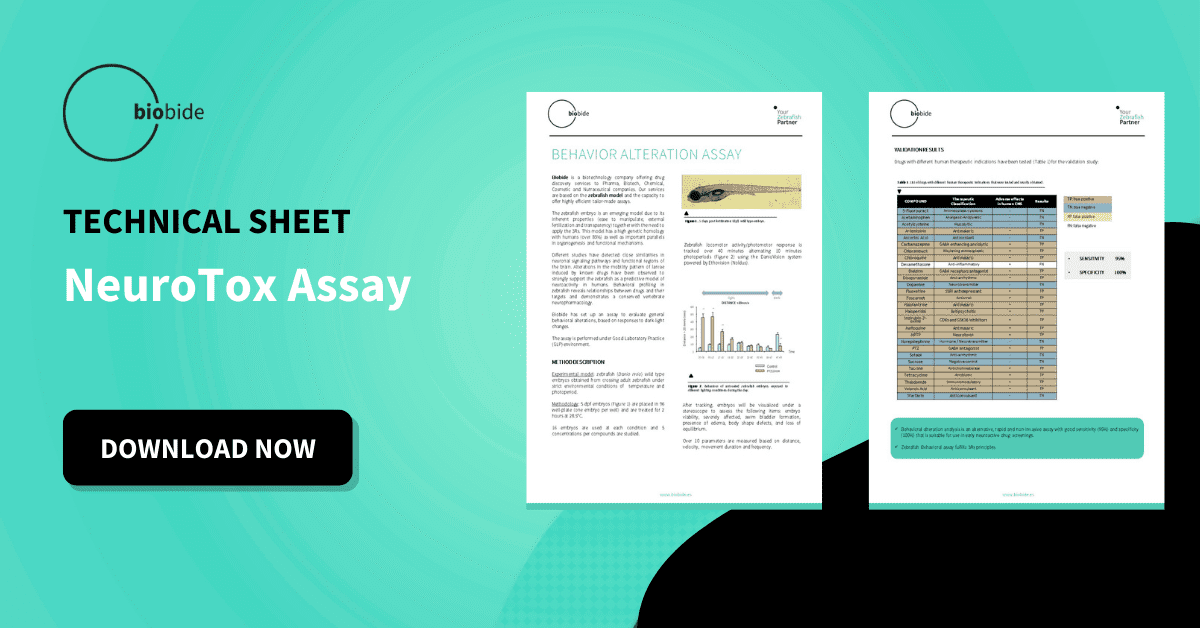No matter how different mammals, reptiles, and bony fish may look today, they all share a common evolutionary history. Early changes to prehistoric organisms led to the development of these vertebrates, leaving common elements between all the animals belonging to the subphylum vertebrata, including anatomical structures and neurological functions.
Zebrafish are one of the many vertebrates whose similarities to humans have made them a popular choice for pharmaceutical research. From High Content Screening (HCS) in early Drug Discovery to advanced studies on the human brain, Zebrafish research provides valuable data and information on how new treatments and diseases affect the biological system.

The complexity of the human brain and the various neuropsychiatric disorders that affect people all over the world are an important part of pharmaceutical R&D. Many of these diseases and disorders continue to need more research in order to find better treatments.
Zebrafish have already been involved in valuable research on Autism Spectrum Disorder (ASD), schizophrenia, Alzheimer’s Disease (AD), and other neurological diseases. The quick development cycle of these animals and their transparent embryos offer an efficient and effective way to study the brain as it develops into adulthood.
As a vertebrate homologue, the structures and functions found in both Zebrafish and human anatomy give researchers access to a practical alternative animal model for neurological research. With in vivo tests, scientists can then alter and control human neurological genes in order to observe how those changes affect a living, functioning brain.
Pharmaceutical research into the treatment and prevention of neurological diseases in humans can begin making progress towards clinical trials by using Zebrafish.
Zebrafish and Human Neuroanatomy
The structure and morphology of Zebrafish brains are comparable to other mammals often used in Drug Discovery. Both the macro-level structure and the micro-level cells share elements with humans that can be easily modulated and observed.
The habenula is a well-conserved group of nerve cells found in all vertebrate animals, playing an important part in sleep-wake cycles, reproductive behaviors, and moods (including depression). As in humans, the Zebrafish habenula influences the release of serotonin and dopamine, meaning tests and assays looking into serotonin and dopamine levels can use Zebrafish as an effective animal model.
Zebrafish also provide a convenient way to study neuroendocrine systems for research into neurotransmitters, enzymes, and metabolism. The Zebrafish systems are largely homologous to the systems found in mammals, including humans.
The hormones and structures related to how stress affects humans also have a clear homologue in Zebrafish. For example, cortisol controls stress in Zebrafish with specific hormones using glucocorticoid receptors. Humans and other mammals use a very similar process relying on comparable structures. Zebrafish can be used in tests and assays exploring neurological reactions and responses to stress.
Zebrafish have a long history of use in the biomedical industry. With its complete genome sequenced and many genetically modified variants readily available, it’s possible to perform tests and assays at scale while retaining accurate and verifiable results that help move a new treatment towards clinical trials.
The small fish have already been used to study a wide variety of neurotropic drugs as well, giving researchers and scientists a practical way to study mood stabilizers, antidepressants, ethanol, anesthetics, cognitive enhancers, and more.
Studying and Researching Human Diseases in Zebrafish
Sharing homologous systems found in all vertebrates, Zebrafish are an alternative animal model to explore how diseases affect humans.
The many infectious diseases that affect humans are not always easy to understand. It can be hard to see the complicated interactions between the effects of disease and the microscopic pathogen, virus, or other entity. These tiny invaders are only a disease once they come in contact with a host body that meets very specific requirements.
With Zebrafish developing in just 5-6 days post fertilization and sharing around 84% of human disease genes, they provide insight into how diseases manifest and spread in the biological system. Their naturally transparent embryos and homologous structures make them a great candidate for assays on new treatments with clearly observable and verifiable results.
In practice, the same neurodevelopmental tests done with mammals like mice or rats can also be done with Zebrafish. Along with the easily observable embryos and high-volume scalability and throughput, the whole process can be automated with Zebrafish.
Biobide has a proven track record of the assays with Zebrafish as an alternative animal model, including:
- Behavior Alteration Assay
- Novel Tank Diving Test
- Light/Dark Preference Test
Zebrafish Are an Alternative Animal Model for Neurological Research
Many infectious diseases are linked to microscopic pathogens that only become a disease and start harming the biological system when they enter the human body. Drug Discovery is the process of learning everything about how these pathogens interact with the biological system, researching their effects in order to discover treatments.
Zebrafish have already been used to study the pathology of neurological disorders, including Alzheimer’s Disease (AD) and Autism Spectrum Disorder (ASD). These small fish provide comparable neurological information for relevant research and statistically significant data on the human brain. They provide scientists with an ethical alternative animal model for studying in vivo brain functionality and neurophysiology. With a near-endless supply of transparent embryos, HCS and preclinical studies can move quickly to help new treatments start their journey towards the patients that need them.
Zebrafish are a homologous animal model that can lead to breakthroughs in how the scientific community understands neurological diseases.





